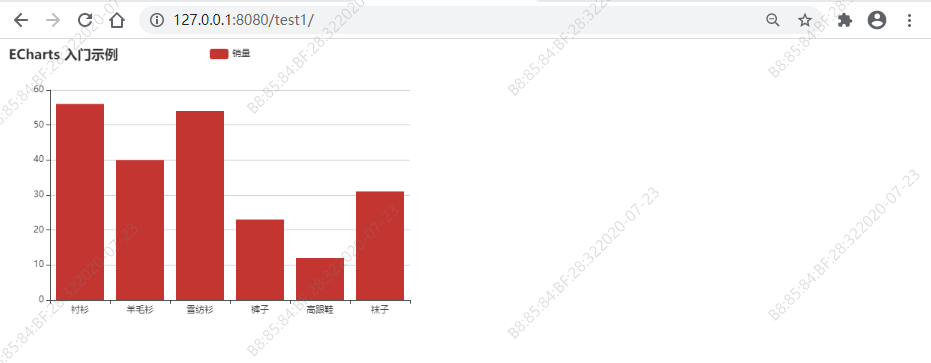Echarts学习:Django快速集成Echarts
django快速使用echarts准备
1.在线定制下载echarts
https://echarts.apache.org/zh/builder.html
2.创建一个django项目或者在已有的项目
- 配置文件中确保数据库配置、static配置、与添加项目名到INSTALLED_APPS下。
- 配置静态文件目录static,目录下创建:css、img、js。
- 保存echarts.min.js到js目录下。
- 创建templates文件,html文件放到此目录。
快速静态测试

<!DOCTYPE html> <html> <head> <meta charset="utf-8"> <title>ECharts</title> <!-- 引入 echarts.js --> {% load static %} <script src="{% static '/js/echarts.min.js' %}"></script> </head> <body> <!-- 为ECharts准备一个具备大小(宽高)的Dom --> <div id="main" style="width: 600px;height:400px;"></div> <script type="text/javascript"> // 基于准备好的dom,初始化echarts实例 var myChart = echarts.init(document.getElementById('main')); // 指定图表的配置项和数据 var option = { title: { text: 'ECharts 入门示例' }, tooltip: {}, legend: { data:['销量'] }, xAxis: { data: ["衬衫","羊毛衫","雪纺衫","裤子","高跟鞋","袜子"] }, yAxis: {}, series: [{ name: '销量', type: 'bar', data: [5, 20, 36, 10, 10, 20] }] }; // 使用刚指定的配置项和数据显示图表。 myChart.setOption(option); </script> </body> </html>

from django.urls import path from app.views import TestView urlpatterns = [ path('test/',TestView.as_view()), ]

from django.shortcuts import render from rest_framework.views import View from rest_framework.response import Response class TestView(View): def dispatch(self, request, *args, **kwargs): """ 请求到来之后,都要执行dispatch方法,dispatch方法根据请求方式不同触发 get/post/put等方法 注意:APIView中的dispatch方法有好多好多的功能 """ return super().dispatch(request, *args, **kwargs) def get(self, request, *args, **kwargs): return render(request, "test.html") def post(self, request, *args, **kwargs): return Response('POST请求,响应内容') def put(self, request, *args, **kwargs): return Response('PUT请求,响应内容')
访问url地址:

django获取数据库中的数据传递给echarts

<!DOCTYPE html> <html> <head> <meta charset="utf-8"> <title>ECharts</title> <!-- 引入 echarts.js --> {% load static %} <script src="{% static '/js/echarts.min.js' %}"></script> </head> <body> <div id="main" style="width: 600px;height:400px;"></div> <script type="text/javascript"> // 基于准备好的dom,初始化echarts实例 console.log(name) var myChart = echarts.init(document.getElementById('main')); // 指定图表的配置项和数据 var option = { title: { text: 'ECharts 入门示例' }, tooltip: {}, legend: { data: ['销量'] }, xAxis: { data: {{ name|safe }} }, yAxis: {}, series: [{ name: '销量', type: 'bar', data:{{ data|safe }} }] }; // 使用刚指定的配置项和数据显示图表。 myChart.setOption(option); </script> </body> </html>

from django.urls import path from app.views import TestView1 urlpatterns = [ path('test1/',TestView1.as_view()), ]

from django.shortcuts import render from rest_framework.views import View from rest_framework.response import Response class TestView1(View): def dispatch(self, request, *args, **kwargs): """ 请求到来之后,都要执行dispatch方法,dispatch方法根据请求方式不同触发 get/post/put等方法 注意:APIView中的dispatch方法有好多好多的功能 """ return super().dispatch(request, *args, **kwargs) def get(self, request, *args, **kwargs): name = ["衬衫","羊毛衫","雪纺衫","裤子","高跟鞋","袜子"] data = [56, 40, 54, 23, 12, 31] return render(request, "test1.html",{"name":name,"data":data}) def post(self, request, *args, **kwargs): return Response('POST请求,响应内容') def put(self, request, *args, **kwargs): return Response('PUT请求,响应内容')
注意:我在views文件中直接返回数据,在html模板中使用标签渲染,如果你需要使用ORM从数据库拿数据,可以做如下操作:
wheelsList = Wheel.objects.all() name = list(Wheel.objects.values_list('name', flat=True)) data = list(Wheel.objects.values_list('trackid', flat=True))
访问url地址:

echarts异步更新数据

<!DOCTYPE html> <html lang="en"> <head> <meta charset="UTF-8"> <title>Title</title> <!-- 引入 jquery.js--> <script src="http://code.jquery.com/jquery-latest.js"></script> <!-- 引入 echarts.js --> {% load static %} <script src="{% static '/js/echarts.min.js' %}"></script> </head> <body> <div id="main" style="width: 600px;height:400px;"></div> <script type="text/javascript"> $(function () { var server_info; var myChart = echarts.init(document.getElementById('main')); var option = { title: { text: 'ECharts 入门示例' }, tooltip: {}, legend: { data:['销量'] }, xAxis: { data: {{ name | safe }} }, yAxis: {}, series: [{ name: '销量', type: 'bar', data: {{ data | safe }} }] }; myChart.setOption(option, true); setInterval( function () { $.ajax({ type: 'GET', url: '/test1_api/', dataType: 'json', success: function (arg) { server_info = eval(arg); option.xAxis.data = server_info.name; option.series[0].data = server_info.data; } }); myChart.setOption(option, true); }, 2000); window.onresize = function () { myChart.resize(); }; }); </script> </body> </html>

from django.urls import path
from app.views import TestView,TestView1,TestView1api
urlpatterns = [
path('test2/',TestView1.as_view()),
path('test1_api/',TestView1api.as_view()),
]

from django.shortcuts import render from rest_framework.views import View from rest_framework.response import Response from django.http import HttpResponse class TestView1(View): def dispatch(self, request, *args, **kwargs): """ 请求到来之后,都要执行dispatch方法,dispatch方法根据请求方式不同触发 get/post/put等方法 注意:APIView中的dispatch方法有好多好多的功能 """ return super().dispatch(request, *args, **kwargs) def get(self, request, *args, **kwargs): name = ["衬衫","羊毛衫","雪纺衫","裤子","高跟鞋","袜子"] data = [56, 40, 54, 23, 12, 31] return render(request, "test2.html",{"name":name,"data":data}) def post(self, request, *args, **kwargs): return Response('POST请求,响应内容') def put(self, request, *args, **kwargs): return Response('PUT请求,响应内容') count = 1 class TestView1api(View): def dispatch(self, request, *args, **kwargs): """ 请求到来之后,都要执行dispatch方法,dispatch方法根据请求方式不同触发 get/post/put等方法 注意:APIView中的dispatch方法有好多好多的功能 """ return super().dispatch(request, *args, **kwargs) def get(self, request, *args, **kwargs): global count name = ["衬衫","羊毛衫","雪纺衫","裤子","高跟鞋","袜子"] data = [56+count, 40+count, 54+count, 23+count, 12+count, 31+count] count = count + 1 print(data) print(count) ret = {'name': name, 'data': data} return HttpResponse(json.dumps(ret)) def post(self, request, *args, **kwargs): return Response('POST请求,响应内容') def put(self, request, *args, **kwargs): return Response('PUT请求,响应内容')

echarts异步加载+异步更新
在上个示例的基础上,修改test2.html如下:

<!DOCTYPE html> <html lang="en"> <head> <meta charset="UTF-8"> <title>Title</title> <!-- 引入 jquery.js--> <script src="http://code.jquery.com/jquery-latest.js"></script> <!-- 引入 echarts.js --> {% load static %} <script src="{% static '/js/echarts.min.js' %}"></script> </head> <body> <div id="main" style="width: 600px;height:400px;"></div> <script type="text/javascript"> $(function () { var server_info; // 基于准备好的dom,初始化ECharts实例 var myChart = echarts.init(document.getElementById('main')); // 指定图表的配置项和数据 var option = { title: { text: 'ECharts 入门示例' }, tooltip: {}, legend: { data: ['销量'] }, xAxis: { data: [] }, yAxis: {}, series: [{ name: '销量', type: 'bar', data: [] }] }; myChart.setOption(option, true); // 异步加载json格式数据 $.getJSON('http://127.0.0.1:8080/test1_api/', function (data) { myChart.setOption({ xAxis: { data: data.name }, series: [{ // 根据名字对应到相应的系列 data: data.data }] }); }); // ajax异步更新json格式数据 setInterval( function () { $.ajax({ type: 'GET', url: '/test1_api/', dataType: 'json', success: function (arg) { server_info = eval(arg); option.xAxis.data = server_info.name; option.series[0].data = server_info.data; } }); myChart.setOption(option, true); }, 2000); window.onresize = function () { myChart.resize(); }; }); </script> </body> </html>





【推荐】国内首个AI IDE,深度理解中文开发场景,立即下载体验Trae
【推荐】编程新体验,更懂你的AI,立即体验豆包MarsCode编程助手
【推荐】抖音旗下AI助手豆包,你的智能百科全书,全免费不限次数
【推荐】轻量又高性能的 SSH 工具 IShell:AI 加持,快人一步
· 从 HTTP 原因短语缺失研究 HTTP/2 和 HTTP/3 的设计差异
· AI与.NET技术实操系列:向量存储与相似性搜索在 .NET 中的实现
· 基于Microsoft.Extensions.AI核心库实现RAG应用
· Linux系列:如何用heaptrack跟踪.NET程序的非托管内存泄露
· 开发者必知的日志记录最佳实践
· TypeScript + Deepseek 打造卜卦网站:技术与玄学的结合
· Manus的开源复刻OpenManus初探
· AI 智能体引爆开源社区「GitHub 热点速览」
· 三行代码完成国际化适配,妙~啊~
· .NET Core 中如何实现缓存的预热?
2019-07-23 数据的归一化处理